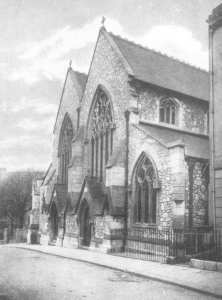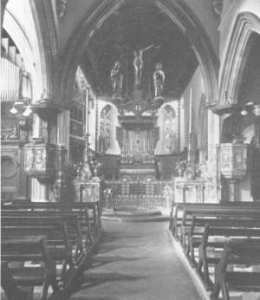|
OLD PLYMOUTH
. UK |
||
|
© Brian
Moseley, Plymouth Webpage created: July 02, 2017 Webpage updated: April 05, 2022 |
||
|
- ANGLICAN CHURCH OF SAINT JAMES THE LESS The Anglican Church of Saint James the Less was situated in Clarendon Place, Citadel Road, Plymouth. It was destroyed during the Second World War and a new Church of Saint James the Less was erected on the Ham Estate Devonport.
The Anglican Church of Saint
James the Less, Citadel Road, Plymouth. The ecclesiastical parish was formed on March 5th 1847 from that of the Ancient Parish Church of Saint Andrew the Apostle, but the parish was a poor one and could not afford a fine building. Initially, services were held 'in a miserable room', which was used on weekdays as an infants school. However, the Reverend G S Hookey, a curate from Saint Andrew's, was placed in charge of the parish and the situation improved soon afterwards.
On Sunday December 31st a room was opened at the Union Baths, in what was then Union Road, as a temporary place of worship. It was said to be 'well papered' and had been fitted out 'with much neatness'. The long, open seats had bee painted to make them look like oak and the communion table was covered with a handsome crimson cloth bearing the initials I.H.S. (Iesus Hominum Salvator - 'Jesus Men's Saviour') but without the cross. To the north of the communion table was a lectern. As the room was not very high it could not hold a pulpit. Only 45 people attended the first service. The seats were to be free to the poor but the Reverend Hookey expressed the wish that those who could afford to would take sittings. At the ceremony for the laying of the foundation stone of the Church (see below), the Reverend Bliss told of the foundation of the school. A sadly un-named lady of the parish visited every house in the locality seeking funds towards such a venture and in Union Street in particular got nothing but refusal. Undaunted, she then approached her friends and asked them how much they would give a week towards a school. Not for a month or a year, she told them, 'I cannot tell if the school will last more than a week'. She then hired a school-room in Bath Street and waited there for a long time before a child made its appearance. Work on erecting the Church started in 1854. The walls had reached about three feet in height when the work was stopped 'owing to a failure of the supplies'. This poor situation began to change when the Reverend James Bliss MA was appointed as incumbent. He at once appointed a curate to look after the spiritual needs of the district while he travelled around the country soliciting subscriptions with which to pay of the debt of £70 left by his predecessor and to build a permanent church and school. By an enormous effort he succeeded in eventually raising the sum of £1,100. The Prince Consort had given £25, the Bishop of Plymouth and the Reverend T A Bewes of Beaumont House had each given £100, and smaller donations were received from the Earls of Fortescue, Devon and Saint Germans, Sir Massey Lopes, Sir Frederic Rogers, Sir J Coleridge, Mr Kekewich MP, Miss Champernowne, Mr Roundell Palmer, Doctor Yonge, Mr Rendle, and Mr Cotton, amongst many others. In the meantime, the school had passed to another lady to look after but she fell ill and the sixty to seventy children had been left in the care of a young assistant mistress. On Thursday May 3rd 1860 the Venerable Archdeacon Downall laid the foundation stone for a permanent building in Citadel Road. The Reverend Bliss told how at Christmas 1859 the infants' school had been placed in the care of a certified master. As a result the attendance was increasing every day. However, there was still a need to erect a school-room near the Church and if that were not possible, then an iron one would be acquired. The sum of £16 9s 3d was collected at the service. The church was of stone in the Early English style and designed by Mr J Piers Saint Aubyn. The initial contractor was Mr Walter Roberts of East Stonehouse, until the job was taken over by Mr Adams. It was consecrated at 11am on Thursday October 24th 1861 by the Right Reverend Aubrey George Spencer, DD, Lord Bishop of Jamaica, who was acting for the Bishop of the Diocese. At that time the Church consisted of a double apsed chancel with north and south chancel-aisles, and a small portion of the nave, altogether affording space for about 330 persons. This included a chamber in the north apse, which was to be used for the school children. The double apse was an unusual feature but it relived the east end of the building from looking too flat. Seven steps laid with Minton's encaustic tiles led up to the altar. On the south side of the altar was sedilia, with three grades, beneath a freestone canopy supported by polished shafts of Devonshire marble. The reredos was composed of Minton's embossed indented and enamelled tiles, with a white marble cross inlaid on a dark red ground, which was sculptured by Mr Bovey, of Plymouth, as were the sedilia. The altar was of solid oak and the oak lectern and temporary pulpit were placed within the chancel screen, which was also of oak. The chancel aisles and that part of the church that had been completed were furnished with open varnished deal benches. The font of Caen stone, richly engraved, had been the gift of the Reverend D M Morrice, a former curate of Saint Andrew's Chapel, and it had already served its holy and useful purpose in the temporary chapels which preceded the Anglican Church of Saint James the Great and the Anglican Church of Saint Stephen, both in Devonport. The font was placed at the temporary western end of the Church. Very handsome gas standards had been supplied by Messrs Singer, of Frome, in Somerset. It was not until 1880 that the Church was completed and in that year the Reverend Bliss retired. The building in the 1930s consisted of a chancel, nave and aisles and an unfinished tower. Three of the windows in the chancel, one in the south aisle and one west window were stained. The church was restored in 1888-91. It at one time sat 600 persons.
An interior view of
Saint James the Less Church, After the Second World War it was decided to use the money gained from War Damage Compensation to build a new Anglican Church of Saint James the Less on the new Council estate at Ham Drive, Devonport. The work started in September 1957 and the foundation stone was laid in March 1958 and it was opened in 1958.
|
||


